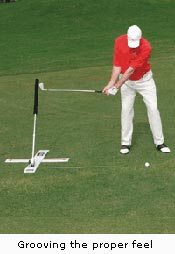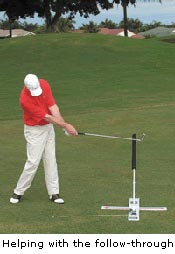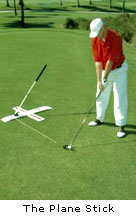GOLF EQUIPMENT
|
|
“I had been out of town and when I came back, I discovered that one of my students had busted up a couple of his clubs using the old shaft in the ground drill,” said Molloy. “I had used that drill in the past, but never let anyone hit any balls at the same time. This guy kind of got overexcited, started swinging at balls with the shaft there and broke some clubs. I finally got fed up with it and decided there had to be a better way to do this.”
He worked with a local engineer and tool-and-die shop to develop several swing-plane prototypes before taking one to last year’s PGA Merchandise Show to gauge interest. “The teaching pros liked it and went kind of crazy over it,” said Molloy. “So we decided to give it a try.”
 Since the official product launch in April 2001, a large shag bag of the top 100 teachers in the Golf Digest and Golf magazine lists have added The Swing Plane to their training arsenals.
Since the official product launch in April 2001, a large shag bag of the top 100 teachers in the Golf Digest and Golf magazine lists have added The Swing Plane to their training arsenals.
Rick Smith, who has counted Jack Nicklaus, Lee Janzen, Phil Mickelson and Vijay Singh among his students, is the spokesperson for The Swing Plane and is the on-camera coach for a 25-minute instructional video that accompanies the product.
The Plane Stick’s main feature is a telescoping aluminum rod that can be adjusted from 33 inches to 46 inches in length and can match the lie angle of any golf club. There is a foam and nylon sleeve covering a breakaway spring on the final 18 inches of the rod. This allows golfers to swing at balls and groove the feel for the proper plane without worrying about hurting their sticks or themselves.
Besides its primary design of eliminating the dreaded over-the-top move, The Swing Plane can also be set up to cure flaws with the set up, follow through, hip sway, excessive head movement and about any other ailment that a golfer can breed and need exorcised.
“The main benefit of the product is that it gives a student the visual and kinesthetic feedback that they wouldn’t otherwise get just hitting golf balls,” said Molloy. “It gives them spatial reference points so they know exactly what their body is supposed to be doing and whether it’s doing it correctly throughout the swing.”
Andy Hinson, the assistant director of instruction at the Golf Academy of Hilton Head at Sea Pines, SC, who uses The Swing Plane with about 90 percent of his students, said the benefits of the product “can be summed up in two words: immediate feedback.”
One of Hinson’s students, Lee Goldstein of North Miami Beach, FL, purchased two of The Plane Sticks for his own personal use.
 “I swing inside out now instead of outside in,” said Goldstein. “I attribute that completely to using this device. I take it in my house. I take it in my office. I take it to the driving range. I carry one with me at all times like it’s a toothbrush.”
“I swing inside out now instead of outside in,” said Goldstein. “I attribute that completely to using this device. I take it in my house. I take it in my office. I take it to the driving range. I carry one with me at all times like it’s a toothbrush.”
“My instructor (Hinson) is normally dead set against quick fixes and training devices,” added Goldstein. “He insisted that I buy this. I bought two.”
For the vast ranks of golfers who think the only way they’ll ever hit a draw is by playing courses south of the equator (Hey, the water spins down the toilet in the opposite direction there, why not a golf ball?), The Plane Stick sounds worthy of a serious look.
How to order and more information
The Plane Stick lists for $149.95 (plus shipping and handling) and can be ordered online at www.planestick.com. The Web site also shows all of the numerous drills that can be done with the product. You can also order by calling 1-866-SWINGPLANE.
Swing Plane Enterprises, Inc.
P.O. Box 4119Pinehurst, N.C.
28374
